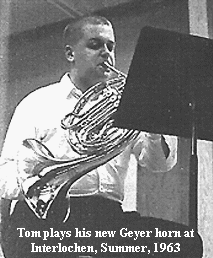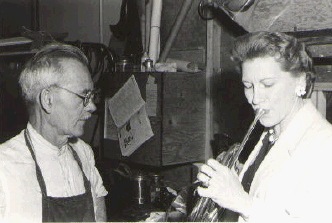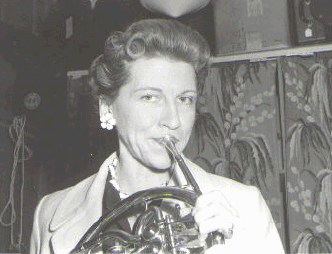Cyberhorn Museum HORN HISTORY: intro | origins | crooks | valves | doubles | tuben MORE: articles | horn books | historic instruments | music terms | HORNPAGE |

Carl Geyer - Chicago 4/9/63
A Reminiscence
by
Thomas BaconI was sixteen years old, had been playing the horn for less than two years, but already knew that I didn't like the beat up old Conn 6D school horn I was using. So, armed with a mouthpiece and my parents' financial backing, I ventured all by myself to downtown Chicago on the hunt for a horn.
I went to Lyon and Healy, Carl Fischer's, etc......tried them all out: Reynolds, King, Conn, Alexander, & Holton (Yamaha hadn't been made yet). Disappointed, I went home empty handed knowing that I would settle for nothing less than the best instrument my parents' money could buy.
Expressing disappointment to my band director the next day, he said, "Why don't you go see Carl Geyer?"
"Who's that?" I wondered aloud.
He kind of chuckled and said, "He only makes the best French Horns in the world."
"So where is he?" I couldn't contain my excitement to meet this man whom I had only heard about seconds before.
"I doubt if he would have time to make an instrument for you, he usually only makes horns for professionals," my band director said, teasing me.
"But where is he? I've got to meet him," I pleaded.
"Well, if you must, then go to Kagan and Gaines downtown, ask for Joe, and tell him you want to meet Mr. Geyer. If they're not too busy, maybe he'll take you back to Geyer's shop."
The rest of that school day was the longest in my life, I rehearsed over and over in my mind what I would say to Joe to convince him that I was worthy to be introduced to Mr. Geyer, and then what I would say to Mr. Geyer when I met him. And I wondered what kind of operation was Kagan and Gaines and who was this Joe anyway? What was I getting myself into? I'm only in high school!!!
If I had been a string player, I would have known that Kagan and Gaines was the place in Chicago to go for instruments, accessories, and repairs. And Joe, it turned out, was the guy who worked the front of the store and took care of Mr. Geyer's business. Carl Geyer, German born and living in the United States since 1903, had somehow become affiliated with Kagan and Gaines as a maker of horns. And tucked away back in a forest of dust covered string basses was the small workshop where this elderly artisan made "the best French horns in the world."
He spoke with a thick German accent and had a sparkle in his eye that enchanted everyone who came into his shop. He was surprised to be visited by such a young player, he was used to dealing with all the pros from the Chicago Symphony and any visiting orchestra that came to town. Seldom did young students come to him wanting to try out one of his horns. He must have been amused by the chubby little high school kid that had come to visit, so he took pause from his work to introduce me to his latest creation.
It was the most beautiful instrument I had ever held in my hands, it looked like it had come straight from French horn heaven, and it had been made, I was told, especially for the first horn player of the Chicago Symphony. I was awestruck, but asked if I might attempt to blow a few notes on it. He said, "Ja, naturally."
So I very carefully put my mouthpiece into the horn and put it to my lips. What happened then was a feeling that could only be described as love. The horn played like a dream, had the most velvety smooth sound I had ever produced on any instrument. I knew that I had found what I was looking for and told Mr. Geyer so. I asked if I could buy one of his horns. He said that he had a lot of orders to fill, but if I would wait six months he would make one for me. And with a sidelong glance at the old, beat up mouthpiece I was using he added, "I vill make new mousepiece for you too."
I was thrilled.
I visited him several times during the six months to try out other horns as he finished them, and was newly convinced each time that his horns were the greatest there could ever be. After his other orders were filled, he finally began work on mine, and my visits to his shop became more frequent as I watched it take shape.
At the time, Mr. Geyer was 83 years old, and his shop was extremely disorderly. It was a tiny room with high ceilings. Brass tubes, leadpipes, old horns and horn parts, valve casings, tools, mouthpieces, and lots of other things lay about in seeming disarray. I never once saw him use a more sophisticated measuring device than a frayed and dirty old piece of string that had several marks on it indicating different lengths. He would take a valve mechanism (which he called "die Maschine"), and solder onto it various little tubes which he extracted out of the mess surrounding him. He would eyeball the curves in the tubes he had to shape, and with an air of disdain for "modern" engineering and construction practices, he would instinctively put together, with remarkable consistency, an instrument that was also a work of art. When, on occasion, an instrument turned out with bad notes or a stuffy tone, he seemed to know intuitively where the trouble lay, and would simply take off the leadpipe or valve mechanism or whatever, replace it with another, and presto, the horn was made well.
Over his lifetime, he made about 1,400 horns, but never did he complete more than one on the same day. It wasn't until the day my horn was finished that I noticed Mr. Geyer's interesting way of numbering his instruments. He finished work on my horn on April 9, 1963. The inscription on the bell was:
Carl Geyer
Chicago
4963I continued to hang out at his shop as long as I lived in Chicago, and Mr. Geyer continued making horns until he was 90 years old. He died in 1973, five weeks before his 93rd birthday. His horns however, continue to live, and it is remarkable how much they have appreciated in value. In 1963 my brand new Geyer horn cost only $680, taxes included. Thanks Mom and Dad!

In the late 1950s, Ethel Merker bought her "umpteenth" Geyer horn. In this picture, she is trying it out under the watchful eyes of the maker:
Yes, it works!
(on the far left, in the background, you
can see one of Geyer's "pieces of string.")
This is hornplanet.com
HOME || HornPage | St. Louis Brass | Opus 90 | Bacon | Golden Horn | Store | Food || CONTACT
| Copyright © Thomas Bacon 1996 - 2009 All rights reserved |
Site Design by Horndog |
|

